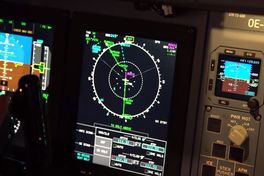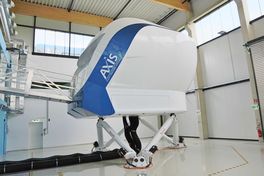In the airline business “efficiency” is the essence. Therefore, we help operators save time by optimizing their total training cost: We strive to provide you with the slots which suit you best in order to reduce the crew’s time off the job. Our easy accessible location, a dedicated team and the reliable FFS are key elements to optimize the benefit of your training.


Pilot Training Courses
Our ATO approvals cover type ratings, TRI and SFI courses, and PBN courses for ATR 42/72-100 up to -600. We also offer license revalidations and renewals, PBN trainings, and Differences Trainings.
Type Rating ATR 72-600 course outline:
- 62 hours of Ground Training with OEM courseware & CBT (12.5 days)
- 11 sessions Flight Training (FBS and FFS)
- 1 session Skill Test
Entry requirements for ATR 72-600 Type Rating course:
The applicant must be a student pilot currently undergoing training on a MPL training course or meet the following requirements:
a. Have at least 70 hours of flight experience as PIC on aeroplanes;
b. Hold a multi-engine IR(A);
c. Have passed the ATPL(A) theoretical knowledge examinations in accordance with Part FCL;
d. Except when the type rating course is combined with an MCC course:
(i) Hold a certificate of satisfactory completion of an MCC course in aeroplanes; or
(ii) Hold a certificate of satisfactory completion of MCC in helicopters and have more than 100 hours of flight experience as a pilot on multi-pilot helicopters; or
(iii) Have at least 500 hours as a pilot on multi-pilot helicopters; or
(iv) Have at least 500 hours as a pilot in multi-pilot operations on single-pilot multi-engine aeroplanes, in commercial air transport.
e. Good command of English (ICAO Level 4 or higher)
f. In addition, for First Officer:
(i) Flight time of more than 500 hours as pilot
(ii) Flight time of more than 200 hours on Part-25/FAR-25 or Part-23/FAR-23 aircraft operated in multi-crew environment
g. In addition, for Captain:
(i) Flight time of more than 1500 hours as pilot
(ii) 500 hours on Part-25/FAR-25 or Part-23/FAR-23 aircraft operated in multi-crew environment For candidates who do not fully meet the flight time requirements, an entry-level training or evaluation of the candidate must be conducted before the type rating course.
The validity of the ATR 42/72 type rating is one year. The revalidation of the rating (LPC – license proficiency check) can be performed within 90 days prior to the expiry date issued in the license. Our examiners are registered with many civil aviation authorities and are able to perform proficiency checks or skill tests for all EASA member states.
In case your type rating has expired, we offer renewal trainings to regain the level of proficiency required to safely operate the ATR 72-600. The amount of refresher training needed is determined on a case-by-case basis and depends on the on-type experience of the applicant, the amount of time elapsed since the expiry of the validity period of the rating and the pilot’s overall flight experience. Our training department reviews your documents and prepares a training program customized to your proficiency. Please contact our sales department for more detailed information on the rules and procedures required by the different national authorities.
The TRI/SFI course comprises 3 modules:
Module 1: Teaching and Learning
(Introduction to training and instructing techniques, candidate evaluation and lecturing). This module will be credited if the applicant already holds or has held a flight instructor license.
Module 2: Technical Course & FFS Training
The technical course enables the instructor candidate to teach the type-specific syllabus for the ATR42/72. Particular attention to multi-crew cooperation is taught in respect of panel flow patterns, checklist strategy, workload management and task sharing. During thef flight training the candidate performs exercises of instruction required to qualify for type rating training privileges.
Module 3: Assessment of Competence
An Assessment of Competence concludes the TRI/SFI course. Depending on the extend of the desired privileges, the assessment takes place at the FFS (TRI restricted with privileges) or at the aircraft (TRI unrestricted).
TRI restricted with privileges
- privilege of type rating instruction on a FFS
- privilege of conducting landing training on an aircraft (base training) after the type rating
- privilege of conducting training flights for recent experience (3 take offs, approaches and landings during 90 days) on a FFS or an aeroplane
- privilege of performung LIFUS after a ZFFT according ORA.ATO.330 (First four landings with TRI on commercial flights)*
*Note: For LIFUS described and in accordance with EU 965/2012 "Air Operations" a TRI license is not required.
TRI unrestricted
- all privileges of a TRI restricted
- privilege of type rating instruction on an aeroplane
Entry requirements for TRI for ATR 72-600:
a) Hold a CPL, MPL or ATPL pilot license on the applicable aircraft category
b) Have completed 1500 hours flight time as a pilot on multi-pilot aeroplanes
c) Have completed, within the 12 months preceding the date of application, 30 route sectors, including take-offs and landings, as PIC or co-pilot on the applicable aeroplane type, of which 15 sectors may be completed in an FFS representing that type
Entry requirements for SFI for ATR 72-600:
a) hold or have held a CPL, MPL or ATPL pilot license on the applicable aircraft category
b) have completed the FSTD content of the applicable type rating course
c) have completed the proficiency check for the issue of the specific aircraft type rating in an FFS representing the applicable type, within the 12 months preceding the application
d) have completed 1500 hours flight time as a pilot on multi-pilot aeroplanes e) completed, as a pilot or as an observer, within the 12 months preceding the application, at least:
(i) 3 route sectors on the flight deck of the applicable aircraft type (on aircraft or FFS); or
(ii) 2 line-orientated flight training-based simulator sessions conducted by qualified flight crew on the flight deck of the applicable type. These simulator sessions shall include 2 flights of at least 2 hours each between 2 different aerodromes, and the associated pre-flight planning and de-briefing
Differences Training is designed to provide the ATR qualified pilot with the theoretical knowledge and practical skills necessary to safely and competently transition between various Non-PEC, PEC and Glass-Cockpit variants of the ATR 42/72. The extent of training needed from one variant to another is defined by the EASA OSD Report.
Operator Training Courses
If entitled by the airline, Aviation Aviation Academy can perform operator trainings like Recurrent Training or Special Airport Training.
As defined in EASA PART-ORO.FC130, each flight crew member shall complete a recurrent training relevant to the type of aircraft on which he or she operates. AAA customizes an efficient and practice-oriented training which fulfils the requirements defined in the customer’s operations manual. Usually, the training is divided into a three-year cycle of ground school and flight instruction, covering all abnormal- and emergency procedures. If needed, we can provide you with type-rated pilots who take over the duties of PM. Other training modules may be included in the training.
Depending on the training specified by the airport authority and the operators’ manuals, the course familiarizes pilots with all aspects of operations at the respective airport, such as regulatory requirements, airport constraints, approach and departure operations, and human factors / CRM techniques that will aid in safe flight operations. During an extended briefing, topics relevant to the operation are discussed, such as AFM limitations, performance planning and criteria, the importance of thorough pre-planning for each arrival and departure, CRM issues regarding these operations, aircraft-specific procedures, and aircraft-specific performance calculations. In the subsequent practical FFS training all aspects of approach and departure operations as well as ground operations are trained. The FFS is equipped with up to date navigational and terrain information which is modelled in exact detail, providing a realistic environment.
Low Visibility Operations (LVO) training prepares pilots to practice ground operations, low visibility take-offs and approaches (normal/emergency ops) as approved by the respective authority.
Dry Lease
Our ATR 72-600 FFS is available for dry lease. Our sales team will assist you by allocating slots and customizing rental packages. Dry lease means rent only – the operation of the simulator is performed by the customer. This increases your flexibility and gives you the freedom to do any training or check flight in complete privacy, directed by your instructor or examiner of choice.